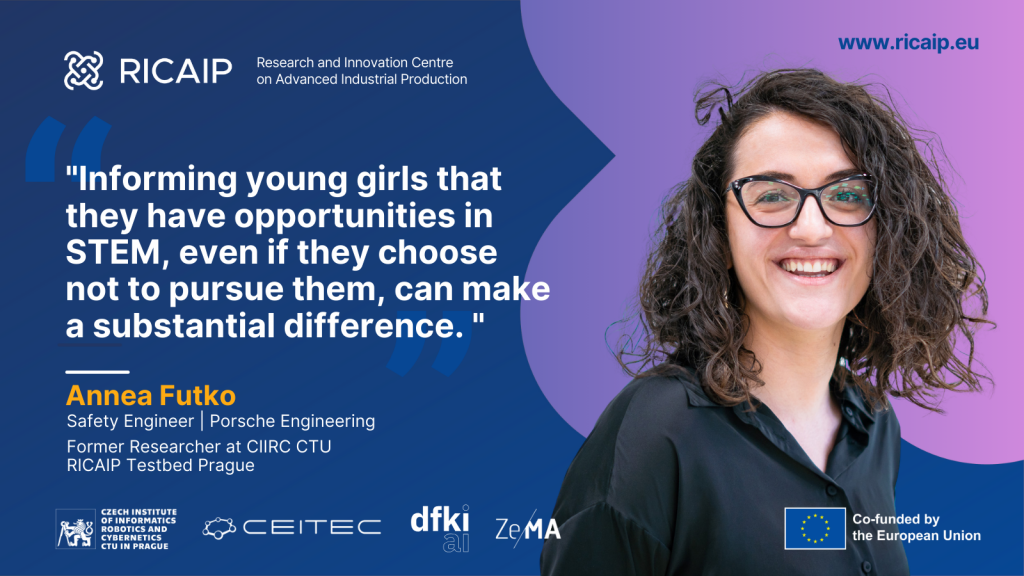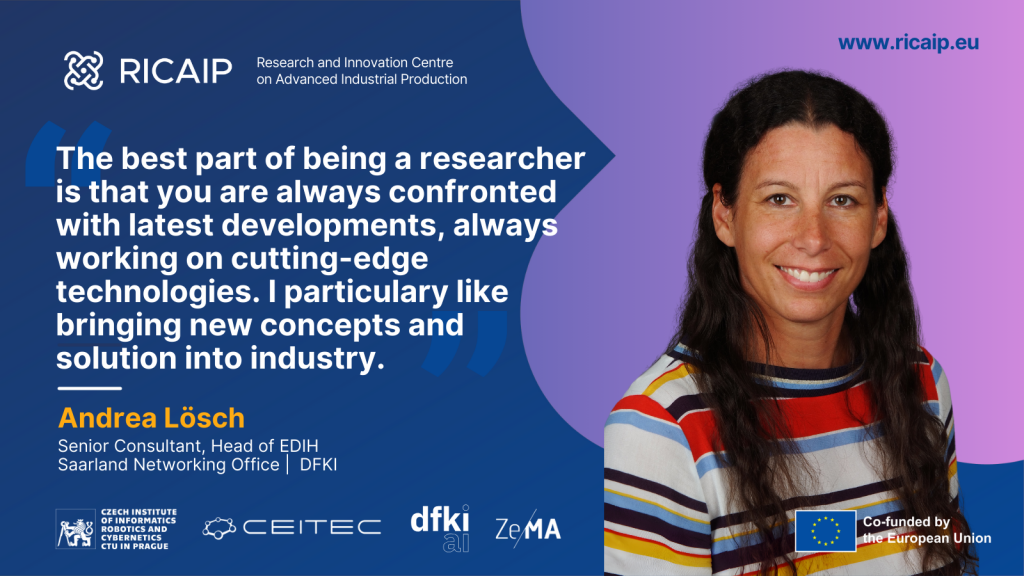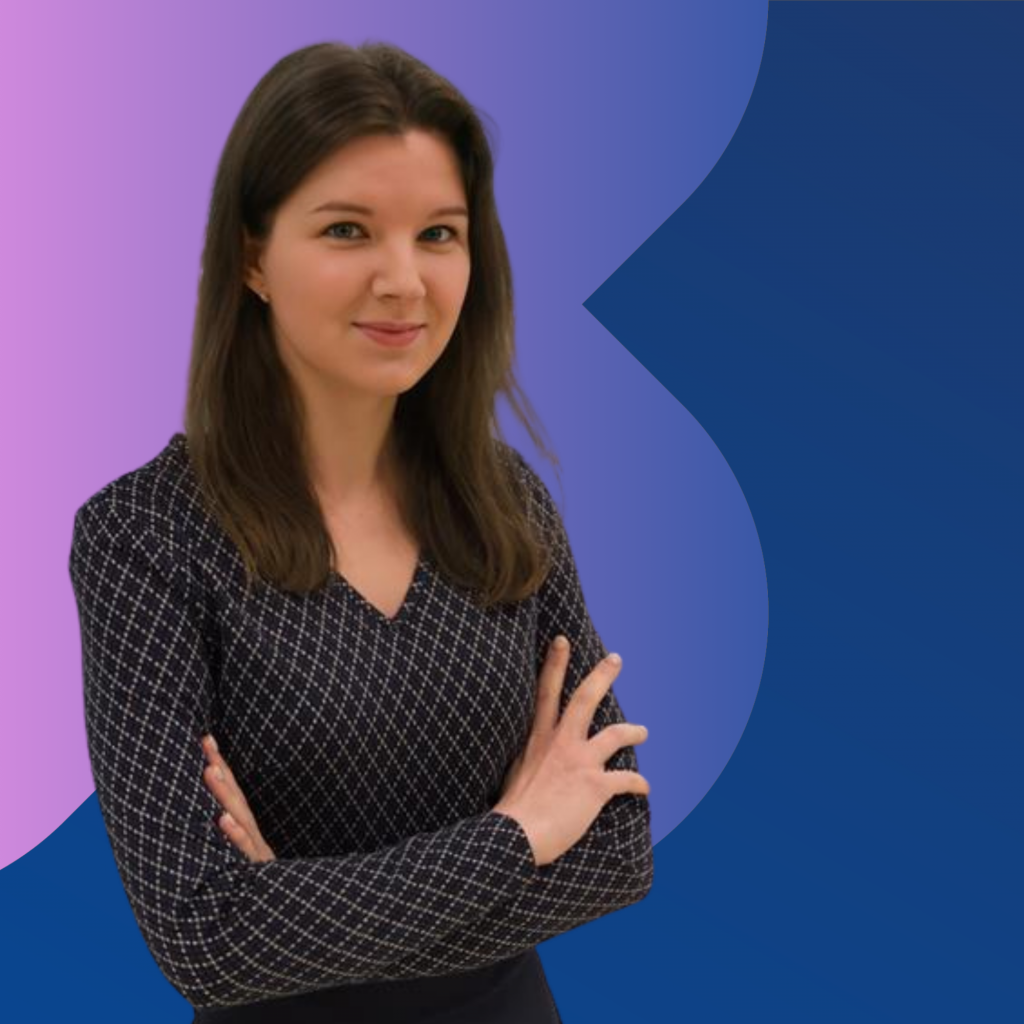At RICAIP, we would like to celebrate the “International Day of Women and Girls in Science“, which was proclaimed by the United Nations General Assembly on 11 February. There are a few interesting women in our teams who deserve our attention. Let us introduce six of them, their research focus and their perspective on variety of topics. This year, meet for example Andrea from DFKI, Marina and Barbora from CIIRC CTU, Annea, our former colleague in RICAIP Testbed Prague, who is now in Porsche Engineering, as well as Raja and Xiaomei from ZeMA.

Research Focus: Digital twins in Industry 4.0 settings as well as in the energy sector
“The best part of being a researcher is that you are always confronted with latest developments, always working on cutting-edge technologies. I particulary like bringing new concepts and solution into industry.”
Bio
My current research interests are on digital twins in Industry 4.0 settings as well as in the energy sector. Previously, I was engaged in language data and language technologies. Since January 2023, I am the team lead for the European Digital Innovation Hub in Saarland where I manage the networking office. EDIH-Saarland is the main regional and cross-regional EDIH for industrial services digitalisation and AI. As such, I support and manage structural change in Saarland and the Greater Region in close collaboration with the State Chancellery and the Ministry for Economy, Innovation, Digitisation and Energy. I also develop and design strategies as well as trainings and qualifications for companies to achieve green and digital transformation in their daily work. My day-to-day task is creating cross-border cooperation and innovation projects between research and industry, between research-driven start-ups and SMEs in the Greater Region.
Would you have any piece of good advice for students?
“Enjoy what you do and find a research topic that you are really fond of and excited about. Also, don’t panic when writing up your thesis – take it step by step. Every journey consists of a number of small steps that you need to take, your dissertation is not different in this respect.”
What do you find the most promising/exciting as a researcher?
“The best part of being a researcher is that you are always confronted with latest developments, always working on cutting-edge technologies, and I particulary like bringing new concepts and solution into industry.”
What do you find most challenging as a female young researcher in a rather male dominated field?
“To be honest, I didn’t even realize that most of my colleagues, especially on the group lead level, are male. The real challenge came when my son was born. However, I appreciate that as a researcher you are very flexible with your work, you can work anywhere, anytime. And this proved to be a real asset for me – and I believe for anyone who has small children.”
Research Focus: Human-robot collaboration
“By cultivating early curiosity and offering inspiring role models, we can empower young women to pursue STEM fields and science careers confidently.”
Bio
In the era of Industry 4.0, where technological advancements are rapidly transforming manufacturing processes, the role of human workers remains pivotal. Despite the automation surge, workers in the manufacturing industry continue to face challenges associated with monotonous tasks and concerns about the perceived dangers posed by large and fast-moving machines. My research addresses the open challenges in human-robot collaboration by introducing an innovative approach that elevates the dynamic adaptability to the user, enhances fault tolerance, and boosts overall productivity. The core of my work lies in developing a scheduling-based dynamic task allocation method between humans and robots. This method introduces a novel dimension to human-robot collaboration, providing individuals with the freedom to choose tasks on the production line. This not only alleviates the monotony associated with repetitive work but also increases productivity, as robots can adapt in real-time to product changes or the choices made by human workers. The ethical implications of empowering humans with the ability to choose their tasks redefine the landscape of human-machine interactions, moving away from traditional task allocation methods where humans simply follow machine instructions.
What do you find the most challenging as a researcher?
“As a researcher, the most challenging obstacle I encounter is keeping abreast of the latest developments in the field, necessitating continuous engagement with research articles. Nevertheless, advancements in AI tools, particularly those designed for summarization and information processing, have significantly facilitated this endeavor, streamlining the process and making it more manageable.”
How would you encourage young women to become interested in STEM fields and science careers?
“Based on my childhood experiences of conducting chemical and physics experiments with my dad at home and being inspired by my female physics teacher, I believe sparking an interest in science should begin early. Introducing girls to science through clubs and providing visual examples can make learning enjoyable. To attract more girls to science, it’s crucial to showcase diverse women scientists through introductory meetings or lectures, fostering mentorship relationships.”

Barbora Hudcova
Junior Researcher
CIIRC CTU Prague
PhD Student
Charles University, Prague


Research Focus: Artificial life
“Even though my Ph.D. journey has been challenging at times, there have been moments when I realized that I have derived results no one has seen before me. And that is truly thrilling.“
Bio
“I am currently pursuing my Ph.D. at Charles University, Prague at the Faculty of Mathematics and Physics, Department of Algebra. Additionally, I am a junior researcher at CIIRC CTU where my supervisor Tomáš Mikolov is based.
Together we work on the fascinating topic of artificial life. Our aim is to study dynamical systems that model artificial evolution: a process where structures spontaneously emerge and further grow in complexity in an open-ended manner. Such systems could serve as efficient models of parallel computation and potentially exhibit the emergence of artificial general intelligence.
Particularly, I focus on exploring the classical model of cellular automata. My goal is to anchor the notions of “complexity” and “computational capacity” of such systems into mathematical language in order to study them formally. During my doctoral research, we found new connections to fields such as statistical physics and universal algebra and demonstrated that they provide powerful tools to answer open questions about the systems’ dynamics. I am excited to explore how far can such results be pushed in the future.”
What is your personal motivation for a research career?
“I value the freedom research gives me to pursue topics I find intriguing. It is an honour for me to learn from people who are exceptionally smart and inspiring, and to collaborate with them. Even though my Ph.D. journey has been challenging at times, there have been moments when I realized that I have derived results no one has seen before me. And that is truly thrilling.”
Where are you headed next?
“I have recently handed in my doctoral thesis which I am going to defend soon. If everything goes well, I will continue my research on artificial life as a PostDoc at EPFL in Switzerland. I was lucky to visit the university on an internship during my PhD and I am very excited to return to such an inspiring environment.”

Annea Futko
Safety Engineer
Porsche Engineering
Before: Researcher
RICAIP Testbed Prague
CIIRC CTU Prague


Research Focus: Integration of Augmented Reality in Industry
“Informing young girls that they have opportunities in STEM, even if they choose not to pursue them, can make a substantial difference. “
Bio
While studying in the Cybertnetics and Robotics program at CTU, I had the exciting opportunity to join Testbed RICAIP as a researcher and explore the world of augmented reality. My research focused on bringing this innovative technology into industrial settings, especially in controlling robots. Using Microsoft HoloLens mixed reality technology, I worked on a project dedicated to guiding robots to various positions through intuitive hand gestures. Together with my colleagues,we successfully expanded the application of this technology into different workcells too.
The supportive and lively atmosphere at RICAIP, along with the chance to work alongside experienced professionals and use advanced technology, made for an incredibly enriching experience. For young researchers looking to connect their academic knowledge to real-world applications, RICAIP provides a fantastic opportunity in its dynamic labs.
What do you find the most challenging as a researcher? Did RICAIP project help you achieving something in particular?
“Being part of RICAIP was a really good step into being in research. It’s not just a place to work; it’s where I got to experience the essence of research, collaborate with others, and explore different projects.
One of the significant challenges, from my perspective, is bridging the gap between theoretical knowledge and practical application. RICAIP addresses this challenge by offering a unique environment equipped with a wide array of Industry 4.0 technologies, robotic arms, and diverse workcells. This setting provides an ideal space to apply theoretical knowledge and turn innovative ideas into tangible solutions. It’s truly a great place for anyone passionate about translating knowledge into real-world applications.”
What do you find most challenging as a female young researcher in a rather male dominated field?
“One significant challenge faced by women in STEM is overcoming gender stereotypes and biases. The scarcity of female role models, including teachers, researchers, and engineers, adds an extra layer of difficulty to the journey because, as the saying goes, ‘it’s really hard to be what you cannot see.’ Initiating change from a young age becomes crucial; informing young girls that they have opportunities in STEM, even if they choose not to pursue them, can make a substantial difference.”
How would you encourage young women to become interested in STEM fields and science careers?
“Encouraging young girls in STEM involves making subjects like math, science, and technology enjoyable and accessible. This includes promoting engaging programs and workshops to break the stereotype that STEM is for a select few. Creating a supportive environment is key, fostering curiosity and resilience. Mentorship programs and networking connect aspiring female scientists with experienced professionals, bridging gaps and instilling a sense of belonging. Success stories of women excelling in STEM further inspire, proving that gender should never hinder greatness in these fields.”

Raja Moktafi
Researcher
ZeMA gGmbH
Laboratory for Human-Robot Collaboration at Power4Production Saarbrücken


Research Focus: Human-Robot Collaboration
“As a researcher, what excites me the most is developing a software that works. The thrill lies in the journey from conception to realization, where ideas transform into solutions that can solve real-world problems.”
Bio
Raja Moktafi works as a researcher at ZeMA, Center for Mechatronics and Automation Technology in the Robotics group, since September 2023 in Saarbrücken, Germany. She is the project manager of RICAIP in ZeMA and oversees the testbed of human intention recognition for human robot collaboration.
Raja’s academic journey led her to pursue a Master’s degree in Technical Systems at University of Applied Sciences Ruhr West (Campus Mülheim), which she successfully completed in 2020. During her Master’s thesis at Krones AG, she created a machine learning-based software integrated with a camera system for inspecting and ensuring product quality. The software effectively identifies and measures the angle of inclination of containers on a conveyor belt, detects any damages inside boxes destined for packaging, and verifies the condition of boxes in the presence of foreign particles.
Afterward, Raja has embarked on a career in the industrial sector for three years in Krones AG, focusing on machine learning, particularly in supervised learning. And programming industrial robots, particular motion control and safety. She has implemented safety protocols that ensure the well-being of human operators. This involved emergency stops mechanisms, and fail-safe algorithms to minimise risks in industrial settings.
What do you find the most challenging as a researcher?
“As a researcher that specialize in AI and robotics, I face challenging situations, like: Keeping up with the rapid advancements within AI, which calls for constant sift via an extensive range of potential or beneficial technologies. This necessitates ongoing reading and learning from various resources such as scientific articles, blogs and code repositories. Additionally, finding and building sturdy collaboration between researchers from diverse disciplines to solve complicated research problems.”
What do you find the most promising/exciting as a researcher?
“As a researcher what excite me the most is developing a software that works. The thrill lies in the journey from conception to realization, where ideas transform into solutions that can solve real-world problems. A journey filled with discussions, searching, coding and bugs fixing.”
What do you find most challenging as a female young researcher in a rather male dominated field?
“There are many challenges that a female researcher might face, which, for now doesn’t apply to my situation, such as securing equal opportunity for advancement and recognition. Another potential struggle could be building a stable and diverse network.”

Xiaomei Xu
Researcher
ZeMA gGmbH
Laboratory for Human-Robot Collaboration at Power4Production Saarbrücken


Research Focus: Application of camera technology in the industrial field
“If I can be so lucky as to stay in the assembly automation industry, I hope to use every second of my time to break through a little bit more in the field of artificial intelligence and industrial robotics.”
Bio
Xiaomei Xu has been working as a research assistant at the ZeMA Center for Mechatronics and Automation Technology in the Robotics group since April 2020.
In 2019, she graduated with a master’s degree in automation technology from RWTH Aachen University. Xiaomei Xu completed her master’s thesis at the WZL Machine Tool Laboratory of RWTH Aachen University (iCellFactory project). The aim of the iCellFactory project is to build a novel, modularized platform for the cultivation of induced pluripotent stem cells (iPS Cell). In the same year, she was able to publish her master thesis at the 7th CIRP Global Web Conference.
Xiaomei Xu focuses on developing a framework to adaptively relocate collision- and spill-free trajectory planning to the uncertain and dynamic environment. The design (NX) as well as the modeling and simulation was done in Siemens Robot Export and OMPL (Open Motion Planning Library).
During her studies, Xiaomei Xu completed various internships, e.g. at the Research Center Jülich in the field of metal stressing and shaping as well as at the VW Academy Hannover. Here she supported the set-up and roll-out of the VWN Campus Digitalization and supervised workshops on the 3D printing robot arm (planning, programming, implementation) as part of the Ideenexpo 2017.
Since 2020 April she worked for Robotix Academy Project and developed an intelligent system for composing a tangram puzzle with a set of polygons through an industrial robot. In 2021 published at IEEE 17th International Conference on Automation Science and Engineering (CASE) 2021.
Since July 2022, she has been working on the RICAIP project to solve the problem of object recognition and high accuracy 3D pose estimation of industrial parts on Bin Picking challenge, and published in IEEE 10th International Conference on Systems and Control (ICSC) 2022. The Bin Picking sorting system was fully automated after incorporating mathematical methods of point cloud alignment. After completing the construction of the demonstration stand, an article was submitted for the 10th CIRP Conference on Assembly Technology and Systems (CATS) 2024 conference, and will be published in April 2024.
What is your personal motivation for a research career?
“I’ve been working to stabilize AI in industrial robotics operations for a variety of assembly tasks. When I see that, at the end of the day, the robots are faster and better than humans in analyzing and processing problems, I feel as if a part of my soul has been transferred to the robots, and I feel that all the hard work has been worthwhile. If I can always be so lucky as to be in the assembly automation industry, I hope to use every second of my time to break through a little bit in the field of artificial intelligence and industrial robotics.”
Who influenced you most in your research?
“My former group leader, Ali Kanso, had the biggest impact on me. He inspired me a lot in terms of math. In the beginning, my research was limited to combining industrial robots with existing AI methods. After 2 years of being subjected to the strict demands of my group leader, I tried to take a breakthrough step by writing my own mathematical formulas. It was quite a difficult process, but I am always grateful to my group leader for guiding me throughout the 2 years. The current group leader, Attique Bashir, has helped me a lot in writing my thesis, and he is helping me to realize how I should focus my thesis. Last but not least, I would like to thank Prof. Müller, who was the first professor to give me an offer out of the 12 PhD interviews I had and who gave me a lot of affirmation during a very difficult time. I will always stay in my current institute until I finish my PhD.”
What do you find most challenging as a female young researcher in a rather male dominated field?
“I don’t think research has much to do with gender. What’s important is the pure enjoyment of it. Research requires long hours of concentration and should not be disturbed by external problems.”






